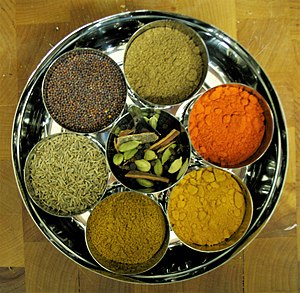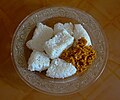南アジア料理
South Asian cuisine/ja

南アジア料理には、現在のバングラデシュ、インド、モルディブ、ネパール、パキスタン、スリランカといったja:南アジア諸国、そして時にはブータン王国やアフガニスタン首長国も含む伝統的な料理が含まれる。デシ料理とも呼ばれ、インド亜大陸以外のアジア料理にも影響を与え、また影響を受けてきた。
主食と一般的な食材

チャパティという平たいパンは、インド亜大陸の多くの地域で一般的な食事の一部である。他の多くの料理の主食には、米、アタ粉で作られたロティ、豆類などがある。
この地域の料理は、様々な種類の唐辛子、黒胡椒、クローブ、その他の強いハーブやスパイス、そして風味付けされたバターであるギーで味付けされている。生姜は、この亜大陸の料理では、風味豊かな料理にも甘い料理にも使うことができる食材である。刻んだ生姜は肉と一緒に炒められ、生姜のピクルスはよく炊いたご飯に添えられる。生姜汁やシロップで煮た生姜はデザートを作るのに使われる。ウコンとクミンはカレーによく使われる。
一般的な肉には、ラム、ヤギ、魚、鶏肉、そして牛肉が含まれる。牛はヒンドゥー教で特別な位置を占めるため、インドでは他の南アジア料理に比べて牛肉は一般的ではない。牛肉の禁止は、ある程度(水)水牛やヤクの肉にも及ぶ。豚肉は、すべてのムスリムにとってタブーな食べ物とされており、多くのヒンドゥー教徒にはタブーではないが避けられている(ただし、北東インドやゴアなど一部の地域では一般的に食べられている)。乳製品を使った非常に甘いデザートも、インド亜大陸の料理には多く見られる。インド亜大陸のデザートの主な材料は、煮詰めた牛乳、挽いたアーモンド、レンズ豆の粉、ギー、砂糖である。キールは乳製品ベースのライスプディングで、一般的なデザートである。
History
Many foods from the subcontinent have been known for over five thousand years. The Indus Valley people, who settled in the northwestern Indian subcontinent, hunted turtles and alligator. They also collected wild grains, herbs and plants. Many foods and ingredients from the Indus period (c. 3300–1700 B.C.) are still common today. Some consist of wheat, barley, rice, tamarind, eggplant, and cucumber. The Indus Valley people cooked with oils, ginger, salt, green peppers, and turmeric root, which would be dried and ground into an orange powder.
Indians have used leafy vegetables, lentils, and milk products such as yogurt and ghee throughout their history. They also used spices such as cumin and coriander. Black pepper, which is native to India, was often used by 400 A.D. The Greeks brought saffron and the Chinese introduced tea. The Portuguese and British made red chili, potato and cauliflower popular after 1700 A.D. Mughals, who began arriving in India after 1200, saw food as an art and many of their dishes are cooked with as many as 25 spices. They also used rose water, cashews, raisins, and almonds.
In the late 18th and early 19th century, an autobiography of the Scottish Robert Lindsay mentions a Sylheti man called Saeed Ullah cooking a curry for Lindsay's family. This is possibly the oldest record of Indian cuisine in the United Kingdom.
-
Bhang eaters from India c. 1790. Bhang is an edible preparation of cannabis native to the Indian subcontinent. It has been used in food and drink as early as 1000 BCE by Hindus in ancient India.
-
A page from the Nimatnama-i-Nasiruddin-Shahi, the book of delicacies and recipes. It documents the fine art of making kheer.
-
Medieval Indian Manuscript Nimatnama-i-Nasiruddin-Shahi (circa 16th century) showing samosas being served.
By culture
Afghan cuisine
Afghan cuisine is influenced by Persian, Central Asian, and Indian cuisines due to Afghanistan's close proximity and cultural ties. The cuisine is halal and mainly based on mutton, beef, poultry and fish with rice and Afghan bread.
-
Afghan Kabuli palaw
-
Afghan aushak
-
Afghan lamb kebab with yellow saffron rice
-
Naan (bread) from a local baker, the most widely consumed bread in Afghanistan
Bangladeshi cuisine
Bangladeshi cuisine is dominated by Bengali cuisine and has been shaped by the diverse history and riverine geography of Bangladesh. The country has a tropical monsoon climate. Rice is the main staple food of Bangladeshi people and it is served with a wide range of curries.

Islamic dietary laws are prevalent across Bangladesh. Halal foods are food items that Muslims are allowed to eat and drink under Islamic dietary guidelines. The criteria specifies both what foods are allowed, and how the food must be prepared. The foods addressed are mostly types of meat allowed in Islam. Bangladeshi people follow certain rules and regulations while eating. It includes warm hospitality and particular ways of serving as well. This is known as Bangaliketa (Bengali: বাঙালি কেতা). The culture also defines the way to invite people to weddings and for dinner. Gifts are given on certain occasions. Bangaliketa also includes a way of serving utensils in a proper manner. Bengali cuisine has the only traditionally developed multi-course tradition from the subcontinent that is analogous in structure to the modern service à la russe style of French cuisine, with food served course-wise rather than all at once.
Bhutanese cuisine

Bhutanese cuisine employs a lot of red rice (like brown rice in texture, but with a nutty taste, the only variety of rice that grows at high altitudes), buckwheat, and increasingly maize. The diet in the hills also includes chicken, yak meat, dried beef, pork, pork fat, and mutton. It has many similarities with Tibetan cuisine.
Indian cuisine
Indian cuisine is characterized by its sophisticated and subtle use of many Indian spices. There is also the widespread practice of vegetarianism across its society although, overall a minority. Indian cuisine is one of the world's most diverse cuisines, each family of this cuisine is characterized by a wide assortment of dishes and cooking techniques. As a consequence, Indian cuisine varies from region to region, reflecting its ethnically diverse demographics. India's religious beliefs and culture has played an influential role in the evolution of its cuisine. It has influences from Middle Eastern cuisine, Southeast Asian cuisine, East Asian cuisine and Central Asian cuisine, as well as the Mediterranean cuisines due to the historical and contemporary cross-cultural interactions with these neighboring regions.
Regional cuisine includes:
- East Indian cuisines:
-
Bengali Fish meal
-
Odisha style Mutton Curry
-
Rasgulla a famous syrupy dessert from Eastern India
- Northeast Indian cuisines:
-
Assamese Thali
-
Tan Ngang a bread from Manipur
-
Traditional North Indian Vegetarian Thali, India
-
South Indian vegetarian Thali, India
-
Fish moolie Kerala Style
- West Indian cuisines:
- Other Indian cuisines include:
-
A popular Indian Chinese dish
-
Samosa with Pudina Chutney
Maldivian cuisine
Maldivian cuisine, also called Dhivehi cuisine, is the cuisine of the Nation of Maldives and of Minicoy, India. The traditional cuisine of Maldivians is based on three main items and their derivatives: coconuts, fish and starches.
-
Masroshi Maldivian savory snacks
Nepalese cuisine
Nepalese cuisine comprises a variety of cuisines based upon ethnicity, soil and climate relating to Nepal's cultural diversity and geography.Dal-bhat-tarkari (Nepali: दाल भात तरकारी) is eaten throughout Nepal. Nepali cuisine has significant influences from Neighboring Indian and Tibetan cuisines.
Nepalese cuisine includes:
-
Dal-bhat-tarkari is a traditional dish in Nepalese cuisine
-
Plateful of Momo in Nepal
Pakistani cuisine
Pakistani cuisine (Urdu: پاکستانی پکوان) is part of the greater South Asian with significant influence from West Asian cuisines and Central Asian cuisines due to its geographic location and influence. As a result of Mughal legacy, Pakistan also mutually inherited many recipes and dishes from that era alongside India.
Regional cuisines include:
- Balochi cuisine
- Chitrali cuisine
- Kalash cuisine
- Lahori cuisine
- Cuisine of Karachi
- Pashtun cuisine
- Punjabi cuisine
- Saraiki cuisine
- Sindhi cuisine
-
Chapli kebab, a popular kebab from Pashtunistan
-
Sajji, a popular meat dish of Balochistan
-
Ghalmandi with cottage cheese and herbs from Chitral
Other Pakistani cuisine include:
Sri Lankan cuisine
Sri Lankan cuisine has been shaped by many historical, cultural, and other factors. Foreign traders who brought new food items; influences from Malay cuisine and South Indian cuisine are evident.
-
Sri Lankan rice and curry platter
See also
| この記事は、クリエイティブ・コモンズ・表示・継承ライセンス3.0のもとで公表されたウィキペディアの項目South Asian cuisine(11 May 2025, at 06:25編集記事参照)を翻訳して二次利用しています。 |







































